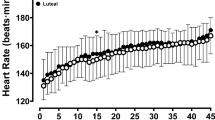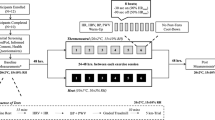Abstract
To determine if heat exposure alters the hormonal responses to moderate, repeated exercise, 11 healthy male subjects [age = 27.1 (3.0) years; maximal oxygen consumption, V˙O2max = 47.6 (6.2) ml · kg · min−1; mean (SD)] were assigned to four different experimental conditions according to a randomized-block design. While in a thermoneutral (23°C) or heated (40°C, 30% relative humidity) climatic chamber, subjects performed either cycle ergometer exercise (two 30-min bouts at ≈50% V˙O2max, separated by a 45-min recovery interval, CEx and HEx conditions), or remained seated for 3 h (CS and HS conditions). Blood samples were analyzed for various exercise stress hormones [epinephrine (E), norepinephrine (NE), dopamine, cortisol and human growth hormone (hGH)]. Passive heating did not alter the concentrations of any of these hormones significantly. During both environmental conditions, exercise induced significant (P < 0.001) elevations in plasma E, NE and hGH levels. At 23°C during bout 1: E = 393 (199) pmol · l−1 (CEx) vs 174 (85) pmol · l−1 (CS), NE = 4593 (2640) pmol · l−1 (CEx) vs 1548 (505) pmol · l−1 (CS), and hGH = 274 (340) pmol · l−1 (CEx)vs 64 (112) pmol · l−1 (CS). At 40°C, bout 1: E = 596 (346) pmol · l−1 (HEx) vs 323 (181) pmol · l−1 (HS), NE = 7789 (5129) pmol · l−1 (HEx) vs 1527 (605) pmol · l−1 (HS), and hGH = 453 (494) pmol · l−1 (HEx) vs 172 (355) pmol · l−1 (HS). However, concentrations of plasma cortisol were increased only in response to exercise in the heat [HEx = 364 (168) nmol · l−1 vs HS = 295 (114) nmol · l−1). Compared to exercise at room temperature, plasma levels of E, NE and cortisol were all higher during exercise in the heat (P < 0.001 in all cases). The repetition of exercise did not significantly alter the pattern of change in cortisol or hGH levels in either environmental condition. However, repetition of exercise in the heat increased circulatory and psychological stress, with significantly (P < 0.001) higher plasma concentrations of E and NE. These results indicate a differential response of the various stress hormones to heat exposure and repeated moderate exercise.
Similar content being viewed by others
Author information
Authors and Affiliations
Additional information
Accepted: 16 April 1997
Rights and permissions
About this article
Cite this article
Brenner, I., Zamecnik, J., Shek, P. et al. The Impact of heat exposure and repeated exercise on circulating stress hormones. Eur J Appl Physiol 76, 445–454 (1997). https://doi.org/10.1007/s004210050274
Issue Date:
DOI: https://doi.org/10.1007/s004210050274




